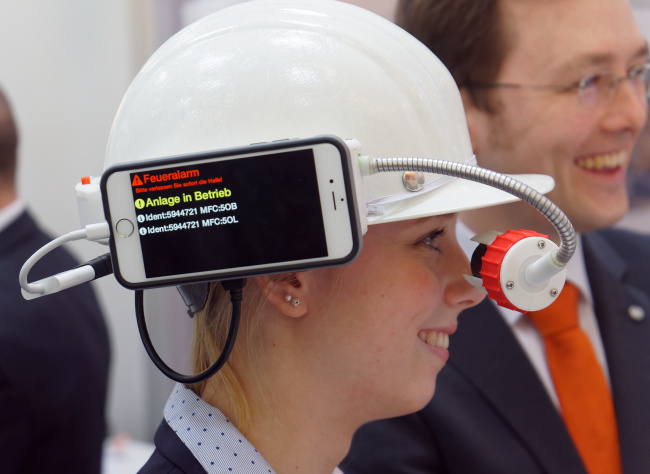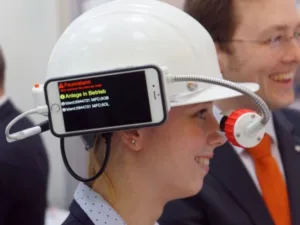I am not trying to trick or mislead anyone in this article, I am a big fan of both technologies and think that they are correctly tagged as the ‘Next Big Thing’. I am also not trying to quote all those great potential applications that are described on a daily basis by many writers around the globe including yours truly. However, I am trying to remain somewhat realistic about the whole augmented and virtual world.

As I see it, there are many hurdles to overcome to make any of these devices a truly ‘must have’ consumer device. The hurdles start with the technical requirements and goes on to content availability and social factors that we haven’t even realized are of any importance in this technical adoption process, yet.
 Source: TheGuardian.com – Samsung VR Event
Source: TheGuardian.com – Samsung VR Event
Technical Hurdles
When you look at the current implementations of head mounted display devices (a good term to describe both types at the moment) you can see that, even though much progress has been made by the hardware developers, we are still far from the perfect headset. One indicator of the development speed is the high number of different approaches that are being pursued by those that want to be market players all over the world. Of course, the fact that investment firms are throwing money at people that can converse fluently about AR/VR terminology does contribute to this wide divergence in technical solutions offered in the market.
Comparing this to other technology developments in the past, I would point to the frantic development efforts after Apple released the first iPad. If you were able to combine a touch screen with an LCD and a microprocessor in a tablet-like form factor, you had a potential winner. Of course, this is not how it turned out, is it? My prediction is that the same kind of scenario will be the case in the AR and VR markets as well.
We still need more technology development, especially in the battery, sensor and processor fields to create a solid platform with good running time to attract consumer buy in.
Than there is the display side. So far, the display technology is more or less borrowed from the smartphone market, even though Oculus claims that their higher price tag is partially caused by using a ‘VR grade OLED’ display*. There is no telling what that actually means, other than their hint of faster switching speeds.
Now, OLEDs are inherently fast and the top switching speed is typically controlled by the type of drivers used rather than the actual OLED cell. Maybe they are using faster drivers for their displays? I doubt that at this point in time they are actually using a display that has optimized cell structures and OLED materials to provide a better VR experience. If they did, they would actually need to know what makes a better display for VR. And I mean more than just an increase in switching speed. What does the light emission cone have to be to control stray light; what are the impacts of minimized power consumption; what are the issues from higher pixel density, are among the questions that come to mind.
Looking at AR, the technology looks similar to the first laptop to me. A description of ‘moveable desktop’ would have been a much better description than laptop. Similarly, the next generation of analyst will have fun creating charts showin these ‘dinosaurs’ of AR hardware in the not so distant future. By then, all AR glasses will be at the same status as the tablet / smartphone is today, a daily necessity.
This technical development is nowhere near as exciting or doesn’t promise as much of a potential return as a ‘social VR’ platform, for example. You just have to remember that one won’t exist without the other!
Content Hurdles
Creating good AR and VR applications requires dealing with a 360 degree representation of the world around us. Our visual system is just built like that. When we react to any audio stimulus, our head / eyes move immediately towards the source. We are just wired like that. Several hundred thousand years of development cannot be forgotten overnight.
 Gamers will be early adoptors of VR. Image:Meko
Gamers will be early adoptors of VR. Image:Meko
Now, there are many more senses that interact with each other to create the ‘real world’ in our brain. The key for good content is to avoid interfering with any of those stimuli and to avoid creating a situation where our brain has to choose to ignore one stimulus over another. This is where we create nausea, discomfort and the like.
Software developers today have not even the faintest idea of what is important and what not. As a consequence, good content is more of a lucky event rather than good implementation of scientific understanding. The underlying science has to be developed before trial and error can be replaced with knowledge. On top of that, game developers have very different ideas of what is good content compared to a developer of a prVR productivity app or a VR experience. Until we come to an understanding of what works and what doesn’t, we just have to keep trying.
Legal & Social Hurdles
I have written often about the Google Glass product and its social awkwardness and also the suggestion of philosophical guidelines to aid in the development of the AR / VR market. All of this is, of course, wishful thinking when investment firms smell the opportunity to make a lot of money with a new technology. This orderly approach is not how our system works today. For example, let us first introduce texting to our smartphones and then worry about not doing this while we are driving. From my observations on the road, I am convinced that running for office with a plan of legalizing texting while driving would get you a lot of votes!
In some countries, certain activities are frowned upon and can get you in to trouble with the legal system. Some countries, like the UK for example, try to protect their people from doing something stupid by banning any such activity from the beginning. A good example is the ban of using AR glasses in a car while driving.
Other countries, like the USA, are of the opinion that every technical platform is a good idea until proven otherwise. Here, there is nothing that a good liability law suit can’t settle – which makes the lawyers happy. Then there are countries where every activity of people is assumed to be suspicious and needs to be controlled. These countries will not be happy with any form of AR and VR until they can control what you are doing while using such hardware.
 AR is not quite ready for consumers, yet. Image:Meko
AR is not quite ready for consumers, yet. Image:Meko
Besides these legal hurdles, there will also be a social factor to be considered.
In a typical social setting (like work for example) we observe how a person reacts to interactions and challenges throughout the day. In a virtual world, we just do not know if we are being observed, so any kind of behavior that maybe unacceptable in direct contact may become acceptable. Just think for a moment of the things people put on their social media platforms. A glorious moment of insanity is there to stay and becomes much less glorious when you are applying for a job. If a virtual activity leads to some questionable ‘virtual behavior’, what does this say about you as a person?
Social boundaries are always being challenged and as a response our social and behavioral system adopts rather quickly. This is one of those cases where we really do not know how the majority will accept the social rules of a rather small group of AR / VR users. Also, it has been suggested by some initial studies, that VR especially has the potential to have a significant impact on the mental state of the user. While this is being researched as a means to treat mental instability (and issues such as autism – Man. Ed.), who says that it won’t be possible to drive a stable person insane with the right content? Could it possibly make users of certain software dependent on its use?
Anyway, looking at the multitude of obstacles AR and VR devices face in the consumer world, my personal guess is that applications with a very narrow scope, like gaming for example, offer the fastest route to building a sizeable market share. On the other hand, writing about something so narrow does not leave a lot of freedom to write about something so fascinating on a daily basis. Letting the mind roam free is a much more rewarding concept for tech bloggers around the globe. So I guess we will have to live with many or all ideas for AR and VR uses until the average consumer decides what makes sense for him and what does not. – Norbert Hildebrand
Statista published this chart which shows that Goldman Sachs also sees professional applications and gaming as the key markets.

You will find more statistics at Statista
* As we reported in our CES report for subscribers, Samsung Display was showing an 800ppi OLED display in its private suite, especially for VR applications. Man. Ed.

